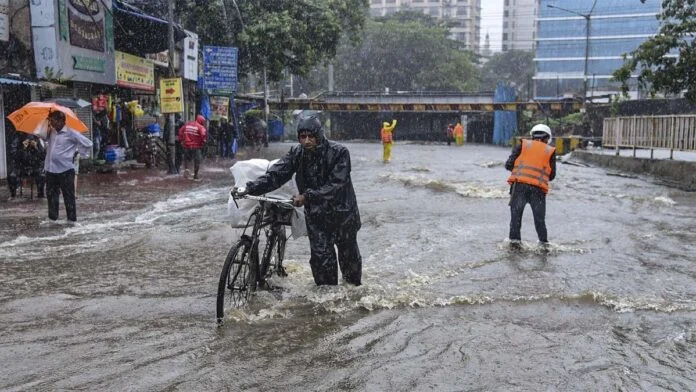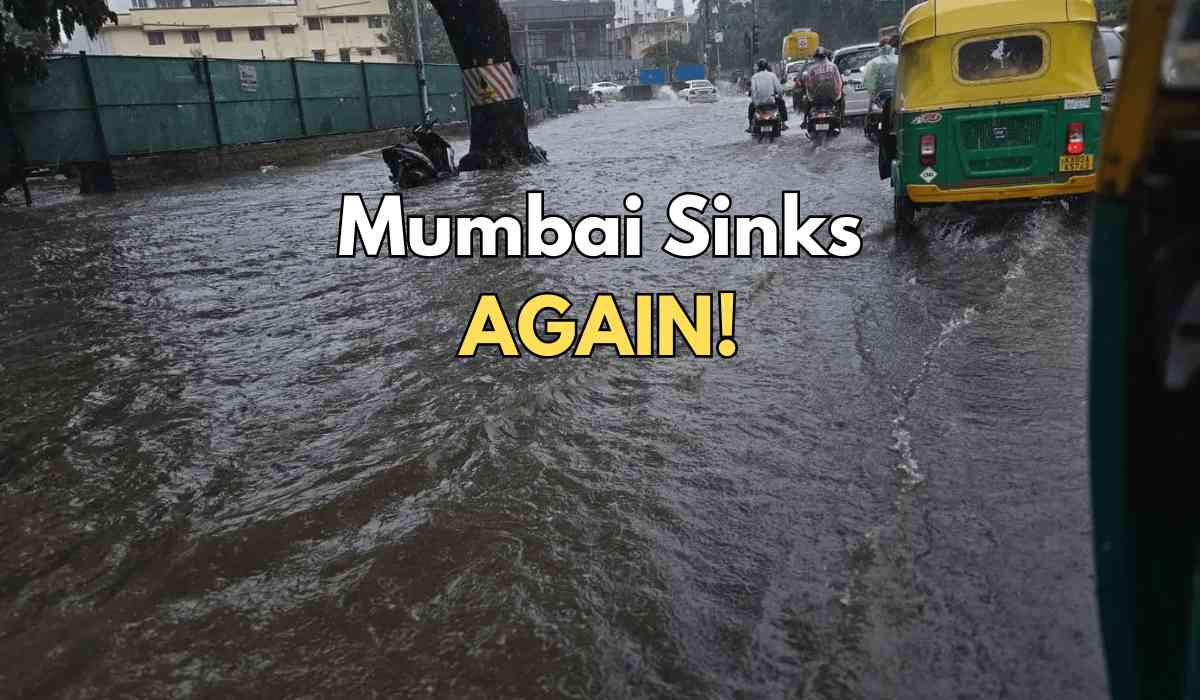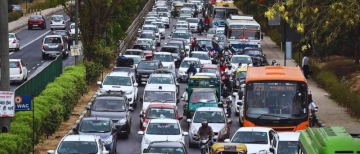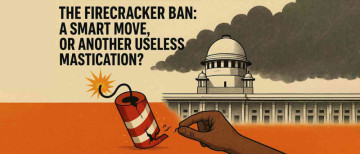Every monsoon, like clockwork, Mumbai—India’s so-called ‘city of dreams’—transforms into a dystopian tableau of waterlogged streets, stranded commuters, collapsing infrastructure, and frustrated citizens. The images are painfully familiar: knee-deep waters, halted suburban trains, abandoned vehicles, and homes invaded by floodwaters. Despite the annual calamity, the civic response remains almost ritualistic—promises are made, reviews are conducted, and then forgotten until the next year’s deluge brings déjà vu all over again.

A City That Sinks Every Year
Mumbai, the country’s financial capital, floods not because it rains, but because the city is systematically stripped of its resilience. With each monsoon, we are reminded that we are at the mercy of an outdated, insufficient, and poorly maintained infrastructure. But is that the price citizens must pay in a city where taxes touch the sky and governance remains buried under water?
Pune: Hoarding Collapses in Heavy #Rain Near #Wagholi, Bikes Damaged #Pune https://t.co/emU0Cyudzb pic.twitter.com/AkpysQ7fba— Punekar News (@punekarnews) May 20, 2025
Why Mumbai Floods—Again and Again
- Outdated Drainage: A Century-Old System for a Hyper-Urban City
Mumbai’s stormwater drainage system dates back to the British era. With over 2,000 km of surface drains and 400 km of underground drains, it was originally designed to manage rainfall of 25 mm per hour—but only during low tide. Today's downpours routinely exceed 50 mm per hour, sometimes even doubling that figure. In other words, the infrastructure is two monsoons behind in capacity and decades behind in intent.
This shortfall was glaring again this year. Between May 20 and May 21, several parts of Mumbai recorded rainfall far exceeding the drainage system's carrying capacity:
-
Jogeshwari: 63 mm
-
Andheri (Malpa Dongri): 57 mm
-
Powai: 38 mm
The mismatch between the system’s ability and the rain’s intensity is literally drowning the city.
Aqua Imagica shifted to Mumbai.
Free Rides. No need to wait till Monsoon. Enjoy the water park in May! #MumbaiRains pic.twitter.com/jhzpi5aDJb— Mumbai Nowcast (@s_r_khandelwal) May 20, 2025
- Low-Lying Areas and Reclaimed Land: Designed to Fail
Much of Mumbai has been built on reclaimed land, much of which is saucer-shaped and naturally low-lying. With inadequate soil filling and flawed city planning, these regions become natural bowls for rainwater during intense showers. Water doesn’t drain away; it settles—sometimes for hours, sometimes for days. Add high tides to the equation, and the water has nowhere to go.
- The Fallacy of Urbanisation: Concrete Over Common Sense
Mumbai’s original drainage system was built on the assumption that only 50% of rainwater would need draining—the rest was expected to percolate into open ground. Fast forward to today, and open grounds are a rare commodity. The city is a slab of concrete. Rainwater has no soil to seep into, so it rushes to the already choked drains, resulting in flooding.
Suburban areas face the worst of this:
-
Nullahs overflow because they're clogged with garbage and construction debris.
-
Roads turn into rivers as encroachments block natural flow routes.
This is Mumbai's world famous Naka..
Saki Naka#MumbaiRains pic.twitter.com/21sMNCInQE— Pritesh Shah (@priteshshah_) May 20, 2025 - The Construction Boom: Progress or Peril?
The city’s breakneck construction boom is touted as a sign of progress. But at what cost? Natural spaces—wetlands, open land, hills, and even rivers—are being bulldozed into oblivion. As trees fall and concrete rises, the city loses its ability to breathe. Debris clogs the few functioning drains. The coastline is barricaded by construction, and hills that once absorbed rainfall now channel it downhill with destructive speed.
- Vanishing Mangroves: Nature's Defence System Destroyed
Mangroves, once Mumbai’s natural guardians against flooding, have been steadily sacrificed at the altar of development. Land reclaimed from mangroves has blocked outflow channels and reduced the land’s capacity to absorb excess water. Environmentalists have long warned that this destruction is a major reason why floodwaters now take much longer to recede.
Pune Comes to a Standstill!
Just a few hours of heavy rain has brought the city to its knees. Major roads like Nagar Road, Sinhagad Road, Solapur Road, Katraj-Dehu Road Bypass, and areas like Wanwadi, Kondhwa, Dhayari, and Hadapsar are witnessing massive traffic shutdowns.
Stay… pic.twitter.com/pOogtj2btX— Pune Pulse (@pulse_pune) May 20, 2025
A Week of Chaos: Death, Disruption, and Delays
The latest spell of pre-monsoon rain in Maharashtra proved deadly. On May 20:
-
Seven lives were lost, including a tragic electrocution of a 10-year-old boy in Pune.
-
In Kalyan, six people died after a building slab collapsed.
-
Hoardings collapsed across Pune and Ahilyanagar, crushing vehicles.
-
A mobile tower collapse injured several people in Satara.
-
Landslides disrupted Konkan Railway services.
-
Two flights—Pune-Goa and Mumbai-Goa—had to be diverted due to low visibility at Goa airport.
In Mumbai, the Andheri subway was closed due to waterlogging, while Minister Yogesh Kadam had to abandon his car and switch to the Metro just to get home.
Yet, the Brihanmumbai Municipal Corporation (BMC) claimed only minor issues were reported—downplaying what has become an annual crisis of epic proportions.
🚨 Floods in Goa, extremely heavy rains in last 24 hours giving more than 200 mm rains. South Maharashtra will also witness rain from this evening . pic.twitter.com/P1K9qmIW8K— Mumbai Rains (@rushikesh_agre_) May 21, 2025
Weather Forecast: More Trouble Ahead
Between May 21 and May 24, the India Meteorological Department (IMD) has forecast:
-
Heavy rainfall is expected across south Konkan, Mumbai, and south-central Maharashtra.
-
Thunderstorms and gusty winds of 30-40 kmph or higher.
-
A cyclonic circulation is forming over the east-central Arabian Sea, likely intensifying in the coming days.
The IMD has issued:
-
Orange alerts (heavy rain warning) for several districts.
-
Yellow notice (moderate rain possibility) for Mumbai.
#WATCH | Maharashtra | The traffic slows down on Western Express Highway following heavy rain across Mumbai. pic.twitter.com/jxnK25lUS5— ANI (@ANI) May 20, 2025
Is This the Best We Deserve?
It’s an honest, painful question that every Mumbaikar must ask: Where is our tax money going?
-
Year after year, crores are allocated for desilting drains. Yet they clog the first day it rains.
-
Coastal Road and Metro projects push on—but not one solution for real-time flood management.
-
Emergency response seems like an afterthought, not a preemptive strategy.
This is not just about poor planning. It’s about negligence.
Mumbai is one of the highest tax-paying cities in the country. We fund the state and the nation with every bill paid, every business started, and every apartment bought. Yet, our returns are potholed roads, flooded streets, and collapsing buildings.
Is this the best a global financial hub can offer its citizens? Is this the future of smart cities? Every monsoon, the same script plays out—only the names of the victims and the inches of rainfall change.
🚨⛈️Little bit of Mumbai rains and we have water logging at Old Nagardas road, Andheri East.
Near Maru Dryfruits.
Where else?
V@mybmc pic.twitter.com/DITzQg7wkB— Jeet Mashru (@mashrujeet) May 20, 2025
Time for Accountability, Not Sympathy
The time for sympathy, promises, and lip service is over. Citizens don’t need apologies. They need accountability.
We need:
-
A complete overhaul of Mumbai’s drainage system—not patchwork fixes.
-
A sustainable urban development plan that respects natural ecology.
-
Strict protection of mangroves and wetlands.
-
Real-time flood forecasting and evacuation systems.
-
Transparency in BMC’s annual flood-preparedness efforts.
Mumbai isn't sinking because it rains. It’s sinking because those in charge have failed to protect it. The tragedy isn’t the monsoon—it’s the apathy that surrounds it.
Until this changes, we will continue to count rainfall in millimeters and governance in excuses.
Views expressed in the above piece are personal and solely those of the author. They do not necessarily reflect Vygr’s views.
With inputs from agencies
Image Source: Multiple agencies
© Copyright 2025. All Rights Reserved Powered by Vygr Media.

























